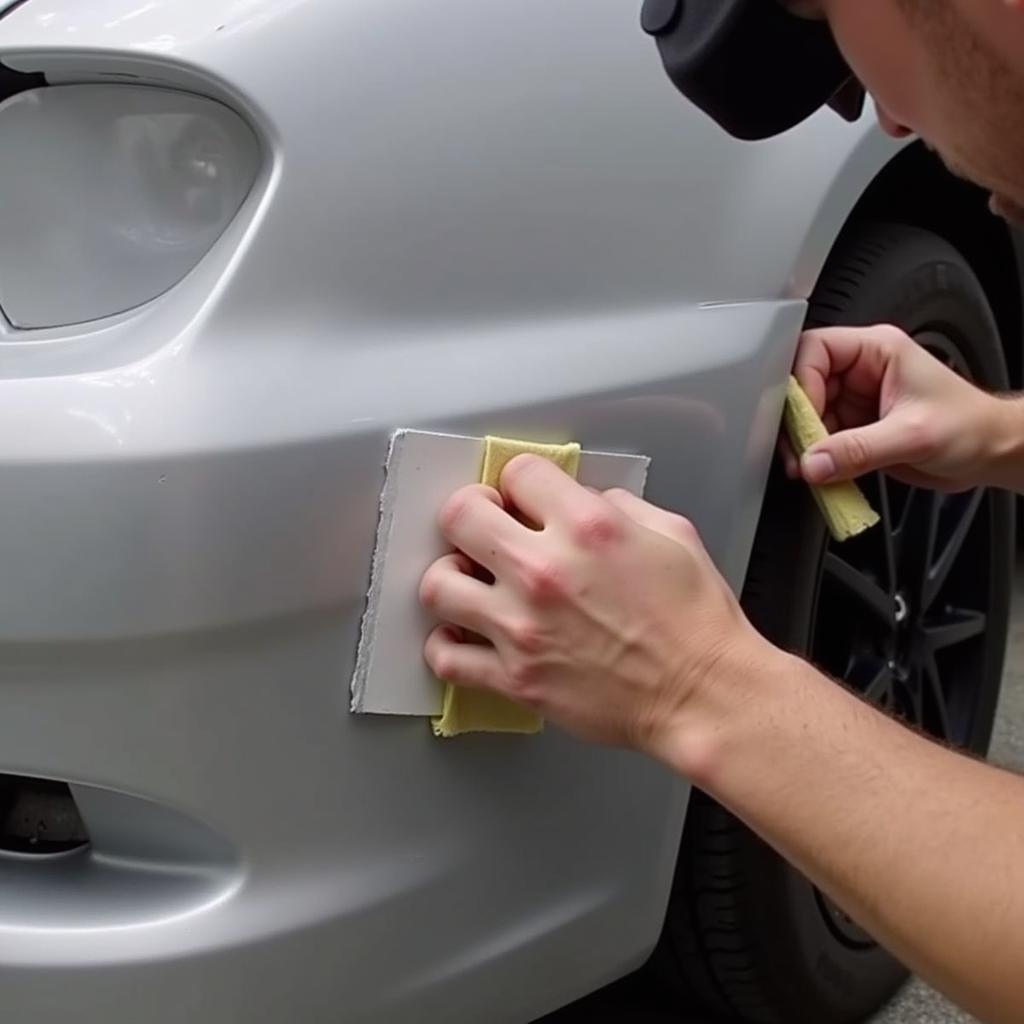A cracked bumper is an eyesore, but removing it can be a real hassle. Thankfully, you can often fix a cracked car bumper without removing it, saving you time and money. This guide will walk you through various effective methods for repairing those unsightly cracks and restoring your bumper to its former glory. Let’s dive in and discover how to fix a cracked car bumper without taking it off. You can learn how to fix car dents yourself if you have any minor dents as well.
Assessing the Damage and Gathering Your Supplies
Before you begin, assess the extent of the damage. Is it a small hairline crack or a larger, more complex split? This will determine the best repair method. For minor cracks, a plastic repair kit might suffice. Larger cracks may require epoxy or specialized fillers. Gather all necessary supplies before starting, including sandpaper, cleaning solution, masking tape, and the chosen repair material.
 Close-up of a cracked car bumper
Close-up of a cracked car bumper
After gathering your supplies, clean the area around the crack thoroughly with a suitable cleaning solution. This will ensure proper adhesion of the repair material. Use masking tape to protect the surrounding paint from any spills or overspray.
Repairing Minor Cracks with a Plastic Repair Kit
For hairline cracks and small chips, a plastic repair kit is a great option. These kits typically include a specialized adhesive and a hardener. Follow the manufacturer’s instructions carefully. Generally, the process involves mixing the adhesive and hardener, applying it to the crack, and allowing it to cure. Once cured, sand the area smooth and blend it in with the surrounding bumper.
 Applying a plastic repair kit to a cracked bumper
Applying a plastic repair kit to a cracked bumper
After sanding, you can touch up the repaired area with paint if necessary. You can learn more about fixing your cracked bumper car with more specific guidelines.
Repairing Larger Cracks with Epoxy or Filler
Larger cracks require a more robust approach. Epoxy or specialized plastic fillers provide a stronger bond and can fill in larger gaps. Mix the epoxy or filler according to the instructions and apply it to the crack, ensuring complete coverage. Allow it to cure completely before sanding and painting.
Choosing the Right Epoxy or Filler
Selecting the correct epoxy or filler is crucial for a successful repair. Look for products specifically designed for automotive plastic. Consider the size and depth of the crack when choosing the appropriate product. Some fillers are designed for flexible bumpers, while others are better suited for rigid plastics.
 Sanding a repaired car bumper
Sanding a repaired car bumper
How to Avoid Further Bumper Damage
Regularly inspecting your bumper can help prevent minor cracks from turning into major issues. Be mindful of parking curbs and avoid low-speed collisions whenever possible. Protecting your bumper with a clear bra or similar protective film can also help minimize the risk of damage. If you’re wondering can you fix a car with water in the engine, it’s best to consult a professional mechanic for severe damage.
Conclusion
Fixing a cracked car bumper without removing it is often possible and can save you both time and expense. By choosing the appropriate repair method and following the instructions carefully, you can restore your bumper to its former glory. Remember to always assess the damage thoroughly before beginning any repair. For expert advice and assistance, connect with AutoTipPro at +1 (641) 206-8880 or visit our office at 500 N St Mary’s St, San Antonio, TX 78205, United States. How to fix car dents yourself can also be helpful if you have any minor dents along with the cracked bumper.
 Finished repaired car bumper
Finished repaired car bumper
FAQ
- Can I use super glue to fix a cracked bumper? While super glue might seem like a quick fix, it’s not recommended for car bumpers due to its brittleness and inability to flex with the plastic.
- How long does it take for epoxy to cure on a bumper? Epoxy curing times vary depending on the product and temperature. Refer to the manufacturer’s instructions for specific curing times.
- What type of sandpaper should I use to smooth the repaired area? Start with a coarser grit sandpaper (around 100-grit) and gradually move to finer grits (200-400 grit) for a smooth finish.
- Can I paint the repaired area myself? Yes, you can paint the repaired area, but ensure you choose the correct paint color and type for your bumper.
- How much does a professional bumper repair cost? Professional repair costs vary based on the extent of the damage and the shop’s rates.
- Is it necessary to prime the repaired area before painting? Priming is recommended for better paint adhesion and durability.
- What can I do to prevent future bumper cracks? Careful parking, avoiding low-speed collisions, and applying a protective film can help prevent future cracks.




Leave a Reply